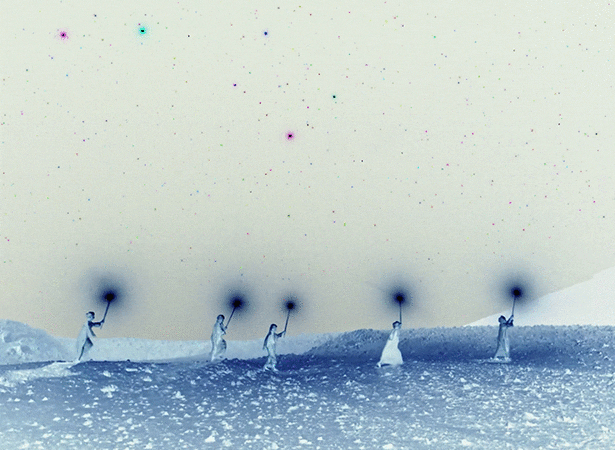Fondazione Merz, Turin, Italy
02 Nov 2016 - 05 Feb 2017

Wael Shawky, Al Araba al Madfuna III, 2015–16. 4k video, 25 minutes. Commissioned by Mathaf: Arab Museum of Modern Art in Doha. Courtesy the artist & Mathaf: Arab Museum of Modern Art in Doha.
Fondazione Merz present Al Araba Al Madfuna, an exhibition of newly commissioned work by Wael Shawky, winner of the first edition of the Mario Merz Prize, curated by Abdellah Karroum.
The site-specific installation centres on the artist’s film trilogy Al Araba Al Madfuna, here shown together for the first time. The viewer is led through a series of immersive environments that physically reproduce the films’ contents—architectural set designs and sculptures specially designed to recreate the original atmosphere of the historical, literary and cinematographic references on which the stories are based.
Al Araba Al Madfuna continues Shawky’s interest, explored in several projects over the last decade, in using existing stories and histories from our culture, as a point of departure for cinematic exploration. Shawky’s work is based on historical narratives, sociological interpretations, and fictional writing, from which he constructs his way of looking at past myths alongside the realities of the present.
The films are inspired by Shawky’s visit to the village of Al Araba Al Madfuna, near Abydos, the archaeological site of the ancient city and a former capital of northern Egypt. There, Shawky lived with its inhabitants for several weeks where he witnessed first-hand the community’s activities of digging underground to search for treasures, using metaphysics, alchemy and spiritual powers to find their ancestors secrets. This truth-seeking journey took the artist-as-explorer to a location currently known as Al Araba Al Madfuna, built next to the archaeological site of a pharaonic kingdom.
Shawky produces the trilogy in a modern theatrical and cinematographic style. Children dressed in turbans, gallabiyas, and moustaches performing the roles of adults, speak the parables from Egyptian writer Mohamed Mustagab’s Dayrout al-Shareif (1983). This is combined with enacted scenes inspired by Shawky’s encounters with the villagers digging tunnels beneath their houses, hoping to find buried treasures from their ancestors. Written in ancient Arabic language, these tales also speak of contemporary concerns; a duality present in the composition of the films.
The first film, Al Araba Al Madfuna I (2012), is based on the short story, The J-B-R’s by Egyptian author Mohamed Mostagab (1938–2005), about a tribe named Al Jabarina. Al Araba Al Madfuna II (2013) draws on two short stories, The Offering and Horseman Adore Perfumes. The first tells of a village mysteriously struck dumb, forcing a reconsideration of methods for trading in a place that previously relied on the power of language and the spoken word. In the second story, a beautiful royal enchantress, feared by her subjects, entraps and marries a series of unsuspecting horsemen who each meet a fateful ending.
The third film Al Araba Al Madfuna III (2015–16), commissioned by Mathaf: Arab Museum of Modern Art in Doha, inspired by Mustagab’s short story, The Sunflower, uses the Ozorion and the temple of the Pharaoh Seti in Abydos as a “natural” set of granite, water, and architectural elements in a place surrounded by myths still unknown today. In this last film, children act as if they were exploring the temple, walking towards it, looking at the walls of hieroglyphs, making gestures and suggesting a scene. We see them act out one story while they are speaking another, citing the words of Mostagab’s novel The Sunflower. In the story the sunflower is a metaphor for inventing change and adopting a new idea. The village transforms the meaning of a plant that had no value into the only worthy treasure.
For this last film, the artist has made a conceptual decision to invert the colours—the greenish water of Abydos turns purple and the white stars in the dark universe become black dots in a milky sky. The first two in the trilogy were filmed in black and white, following in the tradition of classic Egyptian movies. Like the metaphysical activities in the village of Al Araba Al Madfuna, the production of the artwork leaves a substantial part of its components undiscovered.
A catalogue will be published by Fondazione Merz presenting the entire series Al Araba Al Madfuna and their storyboards.
Wael Shawky is the winner of the first edition of the biannual Mario Merz Prize, the first and only international award for contemporary art and music. He was chosen by a jury composed of Manuel Borja-Villel, Massimiliano Gioni, Beatrice Merz and Lawrence Weiner.
In conjunction with Shawky’s exhibition at the Merz Foundation is a retrospective of the artist’s work, curated by Carolyn Christov-Bakargiev and Marcella Beccaria, at the Castello di Rivoli Museo d’Arte Contemporanea.
www.fondazionemerz.org
www.mariomerzprize.org